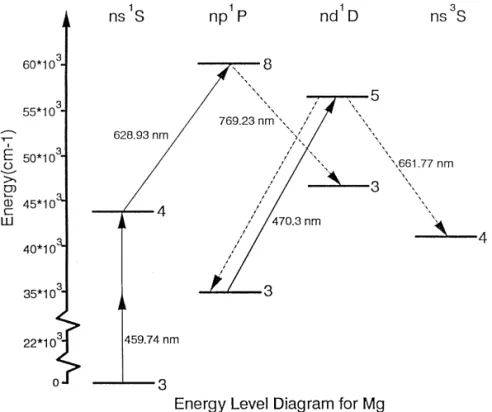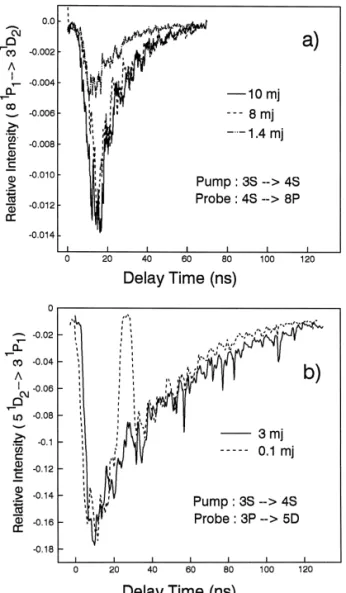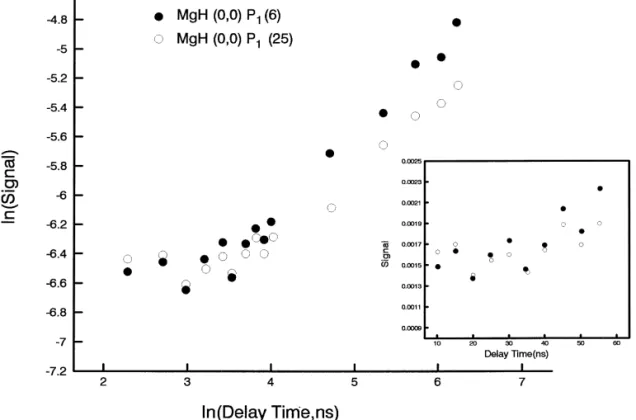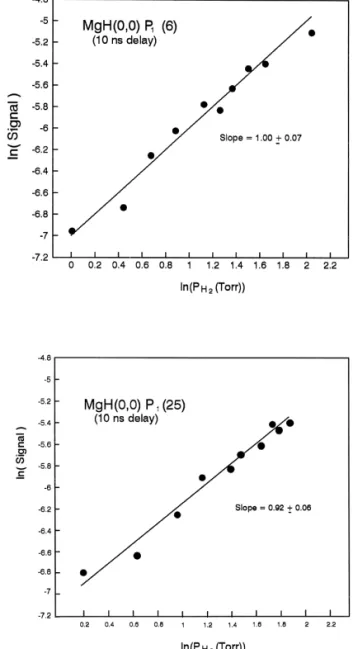Ž .
Chemical Physics Letters 304 1999 336–342
ž
1/
Reaction dynamics of Mg 3s4s S with H : interference of the
0 2ž
1/
MgH product contribution from the lower Mg 3s3p P state
1Dean-Kuo Liu, King-Chuen Lin
)Department of Chemistry, National Taiwan UniÕersity, and Institute of Atomic and Molecular Sciences, Academia Sinica, Taipei 106, Taiwan, ROC
Received 4 January 1999; in final form 9 March 1999
Abstract
Ž 1 .
The nascent MgH product distribution obtained in the reaction of Mg 3s4s S0 with H was found to be identical to that2
Ž 1 . 1
from the Mg 3s3p P1 state. The 4 S population is found to be much larger by a factor ) 18 times than that relaxed to the0 31P state within the pump–probe delay time. The possibility of a secondary production from the 31 1P state appears to be1
negligible in the subsequent measurements of the H2 pressure and the delay time dependences of the MgH rotational lines.
Ž 1 .
These consequences confirm that the MgH product is caused mainly by the direct Mg 4 S –H0 2 collision, rather than a secondary product from the 31P state. q 1999 Elsevier Science B.V. All rights reserved.1
1. Introduction
Ž Y
The nascent rotational distributions of MgH Õ s Y
. Ž 1 .
0 and 1, N in the reaction of Mg 3s3p P1 with H2
have been found to exhibit a bimodal feature, with a major high-N component peaking at large N and a
w x
minor low-N component peaking at N s 7–8 1–7 . Such distributions are caused by a reaction mecha-nism in which Mg approaches H2 in a side-on attack. The bent-shape collision complex may then proceed via a nonadiabatic transition to the ground state surface. The anisotropic interaction of the
Ž .
ground-state potential energy surface PES in the
)
Corresponding author. Fax: q886 2 2362 1483; e-mail: kclin@hp9k720.iams.sinica.edu.tw
exit channel determines the microscopic branching ratio.
The reaction mechanism of a higher state
Ž 1 .
Mg 3s4s S0 with H has also been studied recently2
w x8 . The resulting MgH product distribution was
found to be identical to that obtained by the
Ž 1 .
Mg 3s3p P1 reaction. To study the reaction dynam-ics of the high-lying atomic system, one should be very cautious to avoid reaction product contributions from the relaxed lower atomic states that may inter-fere with the atomic state of interest. Our previous work did not clarify whether the MgH product may be caused by the reaction from the relaxed 31P state1
w x8 . The population ratio between the Mg 3 P and1
1
41S0 state within the pump–probe delay time has not been examined quantitatively. Instead, a rough estimation of population relaxed to 31P was made1
in terms of the spontaneous emission coefficient of
0009-2614r99r$ - see front matter q 1999 Elsevier Science B.V. All rights reserved.
Ž .
2.6 = 107 sy1
for the radiative relaxation from 41S0 1 w x1
to 3 P1 9 . During the delay time adopted, the estimated value suggested that - 25% of the MgH population contribution may result from reaction of the relaxed 31P state. This would be true if the1
Ž 1 .
direct chemical reactions with H2 of Mg 3s4s S0
Ž 1 .
and 3s3p P1 occurred at the same rate.
The 41S ™ 30 1P1 relaxation may be through the following three channels: collisional deactiva-tion, spontaneous emission, and stimulated emission. Among them, the stimulated emission process could
Ž 1 .
produce Mg 3s3p P1 at a rate much faster than the
Ž 1 .
neutral Mg 3s4s S0 radiative lifetime or even the
w x
pump–probe delay time 11 . Since the spontaneous
Ž 1 . w x
emission lifetime of Mg 3s4s S0 of 39 ns 9 is expected to be larger than the effective lifetime of
Ž 1 .
Mg 3s3p P1 at the previous experimental condi-tions, there is a good possibility that efficient stimu-lated emission could have been occurring in the previous system if a population inversion between these two states is reached early in the pump laser
Ž 1 . Ž 1 .
pulse. The Mg 3s4s S –Mg 3s3p P0 1 transition may proceed alternatively via the collisional deacti-vation process. According to ab initio calculations
w x8 , there is an adiabatic avoided crossing of the Ž 1 . w1 x
attractive Mg 3s4s S0 P H2 A1 potential curve
Ž 1 . w1 x
with the very repulsive Mg 3s3p P P H1 2 A1 po-tential curve; this could facilitate the collisional de-activation process, especially if the high-energy Ryd-berg potential surface does not couple readily with other much lower-energy valence potential surfaces
Ž1 . Ž1 1 .
of Mg P r H1 2 B , B . Given the large MgrH2 1
mass disparity, almost all of the 1.1 eV product translational energy gained could go to the lighter H,
Ž 1 .
so that a subsequent reaction of the Mg 3s3p P1
produced in the collisional deactivation with another H molecule will be essentially the same as that of a2
Ž 1 .
thermal Mg 3s3p P1 atom populated by one-photon
Ž 1 .
laser excitation from ground-state Mg 3s3s S . This0 possibility may be consistent with the experimental observation.
Our previous work does not present convincing experimental evidence that the obtained product
dis-1
The spontaneous emission coefficient of 2.6=107sy1for the
41S ™ 30 1P transition corresponds to a lifetime of 39 ns. The1
spontaneous emission coefficient for the 51D ™ 32 1P transition1
7 y1 w x
is 1.6=10 s , in agreement with that reported by Fischer 10 .
tribution is truly nascent and from a direct reaction
Ž 1 .
of Mg 3s4s S0 with H . From the above argu-2
Ž Y Y.
ments, the MgH Õ , N observed may be consid-ered to be primarily a result of reaction of
Ž 1 .
Mg 3s3p P1 with another H molecule. This specu-2
lation is essentially based on the assumption that the population relaxed to the 31P1 state within the pump–probe delay time should be comparable to or even larger than that in the 41S0 state, so that the chemical reaction may be considered to stem from the 31P state rather than from the 41 1S state. In this0 work, we have conducted a series of experiments for comparison of the populations between these two states and examination of the nascent conditions adopted previously. As a supplement to the previous work, the obtained consequences are conducive to
Ž Y Y.
clarifying that the MgH Õ , N distribution
ob-Ž 1 .
served is directly initiated by the Mg 3s4s S0 state, and the contribution from the secondary reaction of
Ž 1 .
the Mg 3s3p P1 state due to relaxation via the above processes is negligible.
2. Experimental set-up
The experimental set-up is similar to the one used
w x
in our previous work 8 . Briefly, two dye lasers, each pumped by an individual Nd:YAG laser, were employed as the radiation sources. The pump laser, which was operated at 459.74 nm, was used to prepare the population in the 41S state via a two-0
photon absorption. The unfocused beam was sent through a pinhole of 6 mm diameter, and the output energy was adjusted in the range of 8–9 mJ. The temporal evolutions of the populations either in the 41S0 or in the relaxed 31P state were monitored1
respectively by a probe laser, of which the time delay relative to the pump laser was varied succes-sively. The probe laser was used to excite the atomic
1 1
Ž .
8p P ™ 3d D laser-induced fluorescence LIF of1 2 the 41S population using the 4s0 1S ™ 8p0 1P tran-1 sition at 628.93 nm with the DCM dye, and to excite the atomic 5d1D ™ 3p2 1P LIF of the 31 1P popula-1
tion using the 3p1P ™ 5d1 1D2 transition at 470.3 nm with the coumarin 480 dye. In the former excita-tion, the emission from 8p1P1 to 3d1D2 at the wavelength of 769.23 nm was monitored, while in the latter one the emission from 5d1D2 either to
D.-K. Liu, K.-C. Lin r Chemical Physics Letters 304 1999 336–342
338
3p1P at 470.3 nm or to 4s1 3S at 661.77 nm was1
monitored. The energy fluence of the probe laser was adjusted to be large enough to achieve a saturation LIF threshold.
The LIF signal thus obtained was collimated onto a monochromator and detected by a photomultiplier tube, closely attached and enhoused in a cooler at
y218C. The quantum efficiencies of the
photomulti-Ž .
plier tube EMI 9658B correspond to 4% and 21%, respectively, for the detection wavelengths at 769.23 and 470.3 nm. The grating of the monochromator is blazed at 600 nm. The transmissions for the wave-lengths at 769.23 and 470.3 nm are roughly the same, when the slit width is open to 0.15 mm used in this work. For monitoring the IR stimulated emission of the 41S ™ 30 1P transition, the probe laser was1
fired first in this work, and then the time delay was varied to cross the pump laser pulse. The related partial energy level diagram related is depicted in Fig. 1.
For examination of the nascent state of the MgH product obtained, specific low and high rotational lines were selected, respectively, and studied as a
function of delay time and H2 pressure. The pump– probe method was similarly employed, but the pump laser was fired ; 10 ns before the probe laser. The line intensity was represented by its area. Like the
w x
previous work 8 , the Mg metal in a five-armed cross heat-pipe oven was heated to 750–760 K, corresponding to a Mg vapor pressure of 40–50 mTorr.
3. Results and discussion
Fig. 2 shows the time-resolved atomic LIFs of the 41S0 state using the 4s1S ™ 8 p0 1P excitation and the 31P state using the 3p1 1P ™ 5d1D excitation. To obtain such results for population evolution, the probe laser was fired either before or after the pump pulse. The pump–probe delay time was varied suc-cessively. The zero delay time is defined as that when the falling edge of the probe laser pulse begins to overlap the rising edge of the pump laser pulse. The saturation of the LIF can be achieved by increas-ing the probe laser energy. In the figure, for atomic
Fig. 1. Energy level diagram of Mg. The solid lines denote the excitation processes conducted by either the pump or the probe laser, while the dashed lines are the emission processes detected.
Fig. 2. Temporal evolution of the fluorescence intensity related to
Ž 1 . Ž 1 .
the population in the Mg 4 S0 and Mg 3 P1 states. The initial population is prepared in the 41S state by two-photon excitation,0
while the probe laser is used to excite atomic laser-induced
Ž . 1 1
fluorescence LIF proportional to the 4 S and 3 P state popu-0 1
lations, respectively. The schemes for the excitation and emission processes for these two cases are referred to in the text. The probe laser is fired either before or after the pump pulse. The delay time
Žpump–probe. is varied successively to cross the pump laser pulse. The saturation of the LIF is achieved with an increase of
Ž .
the probe laser energy. a The excitation process is saturated with the probe laser energy of 8–10 mJ, in comparison with the
Ž .
unsaturated LIF signal at 1.4 mJ. b The saturation is reached with the probe laser energy up to 3 mJ, but the profile of the stimulated emission becomes broadened to merge with the sponta-neous emission profile.
LIF of the 41S0 state, the excitation process is saturated as the probe laser energy is increased from
1.4 to 8 mJ. In contrast, for the atomic LIF of the 31P1 state, the saturation condition is met as the probe laser energy is increased to 3 mJ. Such optical saturation offers an advantage for evaluating the state population of interest. The fraction of popula-tion promoted from the initial to the excited state may be simplified to the ratio of their state degenera-cies. Therefore, for evaluation of the state population one needs to consider only the related spontaneous
Ž .
emission coefficient A . To our knowledge, unfor-fi tunately the spontaneous emission coefficient for the 8p1P ™ 3d1 1D2 transition is not available in the
Ž
literature. The gf values g: state degeneracy; f :
. 1 1
oscillator strength for the 3d D ™ 7p P2 1 and 3p1P ™ 5d1 1D transitions are found to be 0.00862
w x
and 0.424, respectively 10 . The spontaneous emis-sion coefficients correspond to 3.23 = 105 and 2.55
7 y1 w x
= 10 s , respectively 9,12 . Since the transition probability decreases markedly with increasing the
w x
difference of the principal quantum number 13 , the A value for the 8pfi 1P ™ 3d1 1D transition is antic-2
ipated to be smaller than the value of 3.23 = 105sy1
for the 7p1P ™ 3d1 1D transition.2
The population ratio of 41S r 30 1P may be eval-1 uated by
N4 S S rG D4 S 4 S 4 SA4 S
s ,
Ž .
1N3P S rG3P 3PD3PA3P
where S is the intensities for the time-resolved atomic LIFs of the 41S and 30 1P states. The ratio of S1 4S to S3P was estimated to be 1r20 from the integrated temporal profiles within the delay time of ; 25 ns
ŽFig. 2 , which was equivalent to 10 ns adopted in.
the previous experimental set-up. G denotes the ratio
Ž .
of level degeneracies, i.e., G s g r g q g s
4S 8P 4S 8P
Ž .
3r4 and G s g r g qg s5r8. D is the
3P 5D 3P 5D
quantum efficiency of the photomultiplier tube at the detection wavelength. As reported previously, the D values are 4% and 21%, respectively, at 769.23 and 470.3 nm. A is the spontaneous emission coefficient. Since the A value for the 8p1P ™ 3d1 1D2 is
un-Ž 1 1 . known, we adopted A 7p P ™ 3d D1 2 s3.23 = 5 y1 Ž 1 1 . 7 y1 10 s and A 5d D ™ 3p P s 2.55 = 10 s2 1 . Ž .
Substituting the above values in Eq. 1 , accordingly, we have obtained a population ratio of 41S r 30 1P1
Ž .
D.-K. Liu, K.-C. Lin r Chemical Physics Letters 304 1999 336–342
340
Since the A value for the 8p1P ™ 3d1 1D transition2
should be smaller than that for the 7p1P ™ 3d1 1D2
w x 1 1
transition 13 , the 4 S r 3 P population ratio is0 1
Ž 1 1 .
actually larger than 18, if the Afi 8p P ™ 3d D1 2
value may have been considered.
If the population in the 31P state, accumulated1 through various relaxation processes within the pump–probe delay time, is large enough, the subse-quent collision with another H2 molecule may well result in the MgH product with a good signal-to-noise ratio. We may think about this possibility. The initial population in the 41S state prepared by two-photon0
excitation is ordinarily less than that in the 31P1
state excited directly through a one-photon process. This is due to the fact that the excitation cross-sec-tion for the two-photon process is much less than that for the one-photon process unless the laser energy applied is enhanced substantially. According to our observation, the signal intensities for the MgH band-head obtained via either one- or two-photon processes are comparable, when the energies of the unfocused pump laser are adjusted to be 8–11 and
0.1 mJ, respectively, for direct excitation of the 41S0
and 31P state, while the other experimental condi-1
tions remained the same. Recently, we have further
Ž .
conducted the measurement of MgH Õ s 0, N in-tensities obtained by initial excitation either to the 41S or to the 30 1P state. The excitation processes1 are optically saturated, so that the excited popula-tions may be evaluated in terms of the related state
Ž .
degeneracies. The MgH Õ s 0, N intensity initiated by the 41S state is found to be ; 1.5 times larger0
1 w x
than that by the 3 P state 14 . Accordingly, while1
considering the 41S r 30 1P population ratio evalu-1
ated above, one may not anticipate a product distri-bution with a reasonable signal-to-noise ratio ob-tained by the secondary reaction of the 31P atoms1
relaxed from the 41S state.0
As shown in Fig. 2b, a rapid decay of the emis-sion in the 5d1D ™ 3p2 1P transition is observed,1
indicating that an IR stimulated emission from 41S0
to 31P does occur with a response time as fast as1
w x
the pump laser 11 . The stimulated emission decays dramatically to zero within 30 ns. Then an ordinary
Ž . Ž . Ž .
Fig. 3. The LIF signals of MgH 0, 0 P 6 and P 25 as a function of time delay of the probe laser relative to the pump laser at the H1 1 2
Ž Ž .. Ž Ž .. y6 .5
spontaneous emission profile follows. The profile of fast stimulated emission is broadened to merge with the profile of spontaneous emission, as the probe laser energy is increased. However, the peak inten-sity remains invariant once the laser energy reaches
Ž .
the threshold of optical saturation Fig. 2 . When the alternative 5d1D ™ 4s2 3S emission is monitored, a1 population evolution similar to Fig. 2b is obtained.
w x
As reported elsewhere 15,16 , the IR stimulated emission tends to be enhanced in a wave-mixing process usually at an atomic vapor pressure of sev-eral Torr. In Fig. 2b the peak intensity related to the IR stimulated emission is comparable to that of the spontaneous emission. Here we have taken into ac-count the contributions of both types of emissions in the evaluation of 31P -state population, as described1
above.
As shown in Figs. 3 and 4, we have measured the intensity of the MgH rotational lines as a function of delay time and H2 pressure. Note that in these experiments the pump laser is fired before the probe laser. The definition of delay time is thus identical to
w x
that adopted in the previous work 8 , i.e., the delay time is counted from the falling edge of the pump laser pulse up to the onset of the probe laser pulse. The time delay is varied within the range of 10–400 ns. As shown in Fig. 3, the peak intensities of the
Ž . Ž . Ž .
MgH 0, 0 P 6 and P 25 lines appear to weakly1 1
depend on the delay time from 10 to 40 ns at a H2
pressure of 3 Torr. When the delay time is set at 10 ns, on the other hand, a linear proportionality for the H pressure dependence is found within the range of2
Ž .
1.2–7.0 Torr Fig. 4 . The conditions adopted for our
w x
previous work 8 lie in this linear pressure region. Therefore, the possibility of production of MgH obtained previously from a secondary collision has been minimized.
Why are the bimodal features of the MgH
distri-Ž 1 .
butions obtained from Mg 4 S0 similar to those
Ž 1 .
obtained from Mg 3 P ? This fact may be rational-1 ized if the energy disposal of 1.1 eV in the ion-pair Mgq
Hy
complex may be substantially carried away
2
by the H atom. This is possible since the strong instability of Hy
tends to cause most of the available
2
energy to be partitioned into translation. Similar
) w x
examples are also found in the K q H2 17,18 and
) w x
Cs q H2 reactions 19–21 , which have been demonstrated to follow the harpoon-type mechanism.
Fig. 4. The H2 pressure dependence of the LIF signals of
Ž . Ž . Ž .
MgH 0, 0 P 6 and P 25 at a time delay of 10 ns.1 1
In these two systems, ; 70% and ; 90% of the available energies are released as translation,
respec-w x
tively 18,21 . Polanyi and co-workers have devel-oped the related theoretical models characterizing the product energy distribution in the reaction of a
w x
three-atom system via a harpoon mechanism 22,23 . In summary, we have conducted a series of
exper-Ž Y Y.
iments to inspect the possibility of a MgH Õ , N product contribution from a secondary reaction of
Ž 1 .
the Mg 3 P1 atoms formed by relaxed atom of the 41S0 atomic state. However, we find that the
ob-D.-K. Liu, K.-C. Lin r Chemical Physics Letters 304 1999 336–342
342
tained nascent products are mainly caused by the
Ž 1 .
direct Mg 4 S –H0 2 reaction.
Acknowledgements
This work is supported by the National Science Council of the Republic of China under contract No. 88-2113-M-002-011.
References
w x1 W.H. Breckenridge, H. Umemoto, J. Chem. Phys. 80 1984Ž .
4168.
w x2 W.H. Breckenridge, J.H. Wang, Chem. Phys. Lett. 82 1985Ž .
4945.
w x3 P.D. Kleiber, A.M. Lyyra, K.M. Sando, V. Zafiropulos,
Ž .
W.C. Stwalley, J. Chem. Phys. 85 1986 5493.
w x4 P.D. Kleiber, A.M. Lyyra, K.M. Sando, S.P. Heneghan,
Ž .
W.C. Stwalley, Phys. Rev. Lett. 54 1985 2003.
w x5 P. Chaquin, A. Sevin, H. Yu, J. Phys. Chem. 89 1985 2813.Ž . w x6 K.C. Lin, C.T. Huang, J. Chem. Phys. 91 1989 5387.Ž . w x7 Y.R. Ou, D.K. Liu, K.C. Lin, J. Chem. Phys. 108 1998Ž .
1475.
w x8 D.K. Liu, K.C. Lin, Chem. Phys. Lett. 274 1997 37.Ž . w x9 W.L. Wiese, M.W. Smith, B.M. Miles, Atomic Transition
Probabilities, vol. II, NSRDS-NBS 22, US Gov. Print. Off., Springfield, VA, 1969.
w10 C.F. Fischer, Can.J. Phys. 53 1975 184.x Ž .
w11 P.D. Kleiber, A.M. Lyyra, S.P. Heneghan, W.C. Stwalley, J.x
Ž .
Opt. Soc. Am. B 2 1985 522.
w12 J.I. Steinfeld, Molecules and Radiation, MIT Press, Cam-x
bridge, MA, 1981, p. 28.
w13 C. Fabre, S. Haroche, in: R.F. Stebbing, F.B. Dunningx ŽEds. , Rydberg States of Atoms and Molecules, Cambridge.
University Press, London, 1983, p. 117.
w14 D.K. Liu, K.C. Lin, unpublished results.x
w15 P.L. Zhang, Y.C. Wang, A.L. Schawlow, J. Opt. Soc. Am. Bx
Ž .
1 1984 9.
w16 B.K. Clark, M. Masters, J. Huennekens, Appl. Phys. B 47x Ž1988 159..
w17 D.K. Liu, K.C. Lin, J. Chem. Phys. 105 1996 9121.x Ž . w18 D.K. Liu, K.C. Lin, J. Chem. Phys. 107 1997 4244.x Ž . w19 A.G. Urena, R. Vetter, Int. Rev. Phys. Chem. 15 1996 375.x Ž . w20 A.G. Urena, R. Vetter, J. Chem. Soc., Faraday Trans. 91x
Ž1995 389..
w21 X. Huang, J. Zhao, G. Xing, X. Wang, R. Bersohn, J. Chem.x
Ž .
Phys. 104 1996 1338.
w22 P.J. Kuntz, E.M. Nemeth, J.C. Polanyi, J. Chem. Phys. 50x Ž1969 4607..
w23 P.J. Kuntz, M.H. Mok, J.C. Polanyi, J. Chem. Phys. 50x Ž1969 4623..



